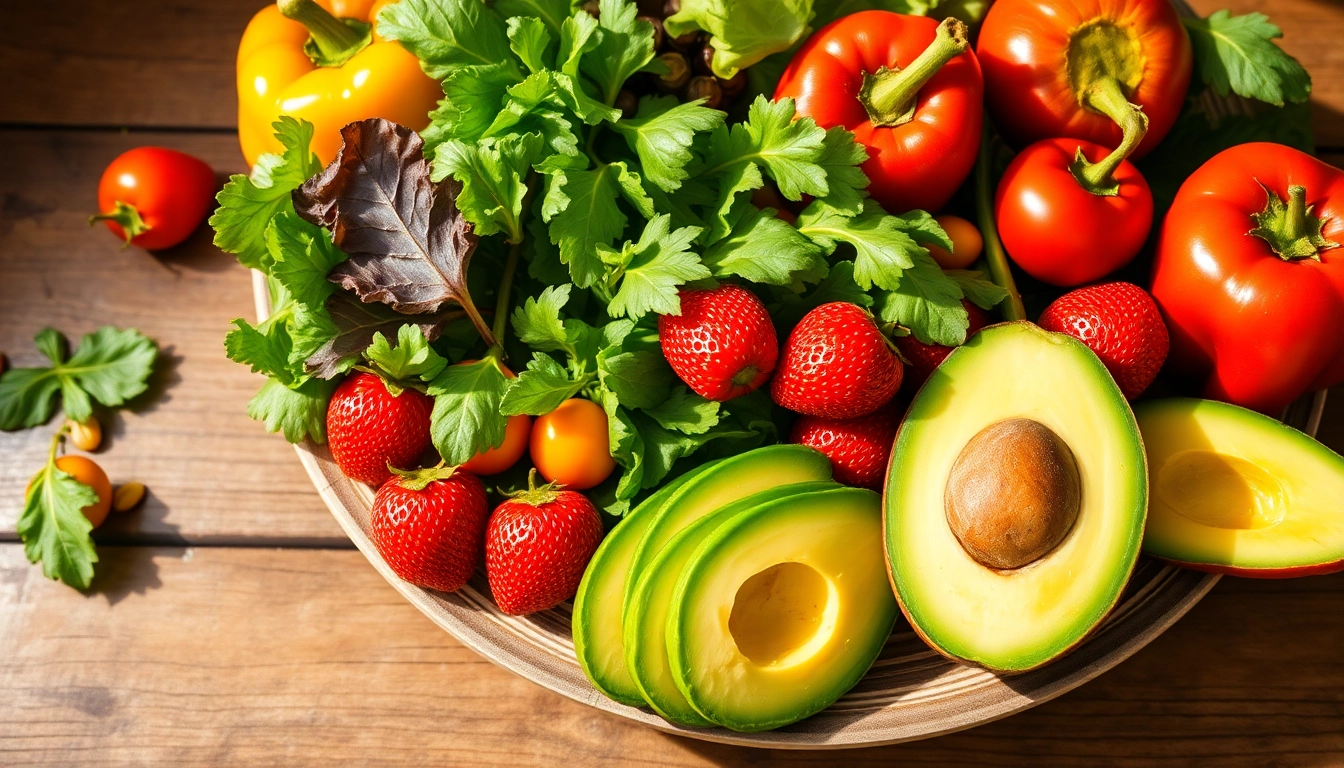The Ultimate Guide to Healthy Food: 10 Essential Choices for a Vibrant Life

Understanding the Importance of Healthy Food
In a world where fast food and processed snacks dominate, understanding the importance of healthy food is crucial for maintaining overall wellbeing. Healthy food constitutes a diverse range of nutrient-rich items that provide energy, promote growth, and support bodily functions. By making informed choices about what we consume, we can significantly influence our health and longevity. Let’s delve into what constitutes healthy food, its numerous benefits, and dissect common misconceptions about healthy eating.
What Constitutes Healthy Food?
Healthy food typically refers to items that are rich in nutrients but low in harmful substances. These include:
- Fruits and Vegetables: Fresh produce, especially colorful fruits and dark leafy greens, are excellent sources of essential vitamins, minerals, and antioxidants.
- Whole Grains: Foods like brown rice, quinoa, and whole grain bread are rich in fiber and can help promote digestive health.
- Nuts and Seeds: Almonds, walnuts, flaxseeds, and chia seeds provide healthy fats, protein, and fiber, making them a great addition to any diet.
- Lean Proteins: Sources such as chicken, fish, beans, and legumes supply necessary amino acids without excessive saturated fats.
- Dairy or Alternatives: Low-fat dairy options or fortified plant-based alternatives offer calcium and vitamin D essential for bone health.
Overall, a balanced diet that incorporates these elements contributes significantly to improved health outcomes.
Benefits of Eating Healthy Foods Regularly
The benefits of regularly consuming healthy foods are profound and multifaceted:
- Enhanced Physical Health: Regular consumption of nutrient-dense foods helps in reducing the risk of chronic diseases including heart disease, diabetes, and obesity.
- Mental Well-being: Nutritional choices can greatly affect mental health; foods rich in omega-3 fatty acids, for instance, have been linked to reduced symptoms of depression and anxiety.
- Weight Management: Healthy foods typically contain more fiber and less sugar, aiding in appetite control and weight management.
- Improved Energy Levels: Nutrient-rich foods provide sustained energy as opposed to the crash that occurs from consuming high-sugar, processed snacks.
- Increased Longevity: Studies consistently show that a balanced diet contributes to a longer, healthier life.
Common Misconceptions about Healthy Eating
Despite the wealth of information available, several misconceptions about healthy eating persist:
- Healthy Foods Are Expensive: Many assume that healthy eating requires expensive superfoods, neglecting the affordability of seasonal fruits and vegetables.
- All Carbohydrates Are Bad: Carbohydrates from whole grains can be beneficial, while refined carbs contribute to health problems.
- Healthy Eating Is Complicated: The idea that healthy eating requires elaborate meal prep ignores the simplicity found in basic, whole foods.
- Once You’re Healthy, You Can Eat Whatever You Want: Even healthy individuals should maintain a balanced approach to food for ongoing health benefits.
Top 10 Healthy Foods You Should Include in Your Diet
To get started on your journey to healthy eating, consider integrating these ten foods into your diet:
1. Leafy Greens: The Nutrient Powerhouses
Leafy greens such as spinach, kale, and swiss chard are loaded with vitamins A, C, and K, fiber, and have been linked with a reduced risk of chronic diseases. They are highly versatile and can be added to salads, smoothies, or served as sides.
2. Fruits: Nature’s Sweet Treats
Fruits, especially berries, apples, and oranges, provide natural sweetness along with vital nutrients and antioxidants. They can enhance any meal and serve as perfect snacks between meals.
3. Whole Grains: The Fiber Engines
Whole grains such as quinoa, brown rice, and oats are excellent for digestive health thanks to their high fiber content. They also provide prolonged energy release, making them ideal for starting your day or as base foods for meals.
4. Fatty Fish: Omega-3 Power
Fatty fish like salmon, mackerel, and sardines are rich in omega-3 fatty acids, known for their heart-healthy properties. Incorporating these into your diet can reduce inflammation and promote brain health.
5. Nuts and Seeds: Small but Mighty
Nuts like walnuts, almonds, and seeds like chia and flax are nutrient-dense foods packed with healthy fats and proteins. They can be added to meals or enjoyed as snacks for a quick energy boost.
6. Legumes: Plant-Based Protein
Legumes such as lentils, chickpeas, and black beans provide an excellent source of plant-based protein and fiber, making them ideal for vegetarian diets. They can be used in various dishes, from soups to salads and stews.
7. Avocado: The Creamy Fruit
Avocado is rich in healthy fats and fiber. It can be used in salads, sandwiches, or smoothies, and is also known for its heart-healthy benefits.
8. Eggs: A Complete Protein
Eggs are one of the most nutritious foods that can be easily integrated into your diet. They are a complete source of protein, containing all essential amino acids, and are also rich in vitamins and minerals.
9. Greek Yogurt: Probiotic Power
Greek yogurt is an excellent source of protein and probiotics. It supports gut health and can be enjoyed plain, with fruits, or in smoothies.
10. Berries: Antioxidant Rich
Berries like blueberries, strawberries, and raspberries are not only delicious but also come packed with vitamins, fiber, and antioxidants that support health and wellness.
Healthy Food Preparation Techniques
Simple Cooking Methods to Retain Nutrients
Cooking techniques can greatly affect the nutritional value of your food:
- Steaming: A gentle method to preserve nutrients in vegetables without added fats.
- Grilling: This method imparts flavor without excessive oils, retaining health benefits.
- Roasting: Enhances the flavors of vegetables and is a simple way to prepare multiple items at once.
- Raw Preparations: Salads and smoothies utilizing fresh ingredients provide maximum nutrient retention.
Meal Prep Ideas for Busy Lives
Utilizing meal prep can encourage healthier choices throughout your week:
- Batch Cooking: Prepare grains and proteins in bulk at the start of the week for easy assembly of meals.
- Pre-portioned Snacks: Divide nuts, fruits, or veggie sticks into individual servings to make healthy snacking easier.
- Use Mason Jars: Create salads in jars that keep fresh throughout the week while making lunches incredibly convenient.
Healthy Substitutes for Common Ingredients
Making simple swaps can improve the healthiness of your meals:
- Avocado Instead of Mayo: For sandwiches and spreads, avocado provides creaminess with healthy fats.
- Greek Yogurt Instead of Sour Cream: This swap offers a tangy flavor and protein boost with lower fat.
- Cauliflower Rice Instead of White Rice: A lower-carb, veggie-packed alternative that supports weight management.
Creating Balanced Meals with Healthy Foods
Understanding Macronutrient Ratios
Creating balanced meals requires understanding the roles of macronutrients:
- Carbohydrates: Should make up about 45-65% of your diet, focusing on complex carbs from whole grains and vegetables.
- Proteins: Making up 10-35% of your intake, opt for lean sources such as lean meats, fish, and plant-based options.
- Fats: Should ideally comprise 20-35% of your diet, with an emphasis on healthy fats from nuts, seeds, and avocados.
Building a Meal Plan around Healthy Food
To create a balanced meal plan:
- Incorporate Variety: Ensure each meal includes different food groups to obtain a spectrum of nutrients.
- Plan for Snacks: Include healthy snacks such as fruits or nuts to maintain energy and avoid cravings.
- Stay Hydrated: Don’t forget to drink plenty of water throughout the day to support health and digestion.
Incorporating Healthy Snacks into Your Day
Healthy snacking can support energy levels and prevent overeating:
- Fresh Fruits: Portable and naturally sweet, perfect for on-the-go consumption.
- Vegetable Sticks with Hummus: Crunchy and satisfying, packed with fiber and protein.
- Homemade Trail Mix: A combination of nuts, seeds, and dried fruits can provide energy and nutrients.
Overcoming Challenges to Eating Healthy Food
Addressing Taste Preferences
Many people resist healthy food due to palate preferences. Here are some strategies:
- Expose Yourself to New Flavors: Gradually introduce new foods into your diet, mixing them with familiar flavors.
- Experiment with Seasonings: Use herbs and spices to enhance the appeal of vegetables and lean proteins.
- Involve Family and Friends: Cooking together makes trialing new recipes fun and less intimidating.
Dealing with Budget Constraints
Eating healthy on a budget is achievable by following these tips:
- Plan Your Meals: Create a meal plan and shopping list to avoid unnecessary purchases.
- Buy in Bulk: Purchase whole grains, legumes, and frozen fruits or vegetables in bulk to save costs.
- Choose Seasonal Produce: They are often cheaper and more nutritious than out-of-season items.
Staying Motivated to Choose Healthy Options
Maintaining the motivation to eat healthy can be a challenge:
- Set Achievable Goals: Start with small, manageable changes rather than complete overhauls.
- Track Your Progress: Keeping a journal can help reinforce positive changes and highlight areas for improvement.
- Find a Support Network: Engaging with others who share similar health goals can help provide accountability.






